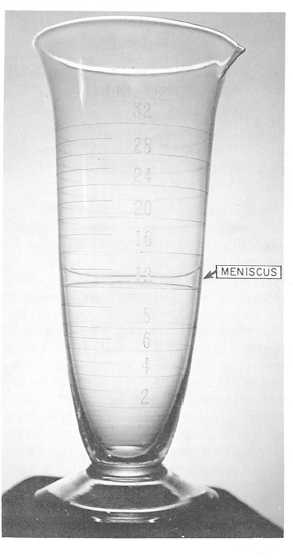HYDROMETERS
237.223
Figure 9-1.–Read tbe lower line of the meniscus when measuring
liquids
thermometer, your eyes should be level with the top of
the liquid column in the capillary tube; otherwise, the
reading may be off as much as 2 or 3 degrees. This error
is due to the refraction of the cylindrical magnifier that
is built into the capillary tube.
Most Navy photographic labs have metal, dial type
of thermometers made of corrosion-resistant steel. They
have a long, thin metal stem, or rod, with a circular dial
indicator at the top. The action of this thermometer is
remarkably fast, and the dial is easy to read.
The accuracy of all lab thermometers should be
checked regularly against one of known accuracy, such
as a Kodak process thermometer.
Another measuring device used in photography is
the hydrometer. A “hydrometer” is used to determine the
specific gravity of a solution. A specific gravity check
is one of the first tests to verify the dilution of a solution.
When the same chemicals are used and when the same
quantity of chemicals and an equal volume of water are
used each time, the resulting liquid is approximately the
same specific gravity each time. This is a characteristic
of that particular solution when all specific gravity
measurements are made at the same temperature.
The specific gravity should stay within an upper and
a lower limit as determined by the manufacturer for each
solution. Variations beyond the upper limit-indicating a
denser or heavier liquid-suggest that more than the
prescribed amount of one or more of the ingredients has
been used, an ingredient foreign to the solution has been
added, or not enough water was added to the solution.
Measurements that fall below standard limits might
indicate that something has been left out, that a foreign
chemical has been substituted, or that more than the
correct amount of water was added.
The silver content of a fixing bath increases as the
bath becomes exhausted. This causes the specific
gravity of the solution to rise. Hence, in addition to
testing the consistency of chemical solutions, specific
gravity tests may be used to check the amount of silver
in the fixing bath. A hydrometer used for this purpose
must be calibrated in grams of silver per liter of solution.
A hydrometer consists of a hollow tube with an
enlarged lower section, or float, topped by a narrow
stem. The lower section is weighted, so the hydrometer
will float in liquids with its stem protruding from the
surface. The stem is graduated with marks that are used
to indicate the density of the liquid in which the
hydrometer floats. When the density of the liquid is high,
it supports the hydrometer more easily, so less of the
stem is submerged. Less dense liquids allow the
hydrometer to sink deeper.
Hydrometers are commonly graduated in terms of
specific gravity. Specific gravity is the ratio of the
density of a substance to the density of distilled water.
However, hydrometers designed for special purposes
have different types of graduated scales. An example is
the hydrometer that is used to check the silver content
of a fixing bath.
Because of the effects of surface tension and
capillary action, a meniscus is formed at the interface
between the solution and the hydrometer stem. The
9-3


